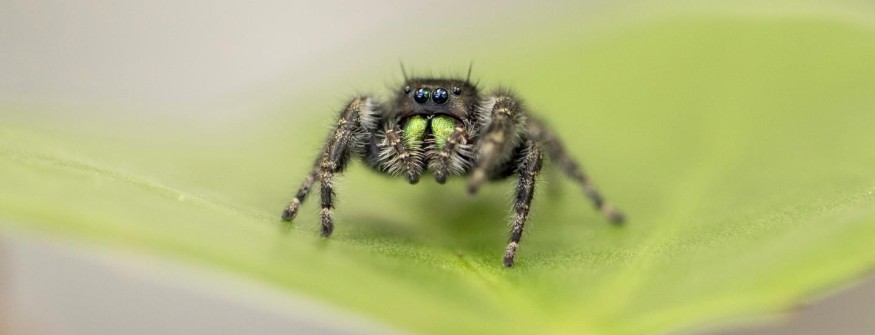Ecologist Daniela Rößler from the University of Konstanz was mesmerized by the small leaping spiders in the field. She found some immovable, hung upside down from a single thread of silk with legs neatly curled-and occasionally moving-jumping spiders, approximately the size of her pinky fingernail, retiring to small silken pouches called "retreats."
Rößler remarks, "The way they twitched reminded me of dogs and cats dozing."

Studying Spiders
Rößler quickly established a spider nursery in her lab to watch the young spiders' nightly dangles. Her latest study, released on August 8 in Proceedings of the National Academy of Science, shows that jumping spiders go through a sleep-like condition and exhibit fast eye movements comparable to those seen in people who are dreaming.
It is believed that "REM sleep," also marked by muscular relaxation and changes in brain electrical activity, is crucial for memory consolidation and may contribute to developing critical survival abilities. Because REM-like sleep has only ever been observed in species with backbones, its discovery in jumping spiders might change our understanding of when and how it developed (reptiles, birds, fish, and most mammals).
As stated by Nate Morehouse, an associate professor at the University of Cincinnati who studied vision and decision-making in jumping spiders and was not involved in the study, "spider intelligence"-and spider dreams-" [are] likely to be in most respects radically distinct from our own." I'm eager to see what this new study has shown about how we can all better comprehend them.
Sleeping Spiders

Although you can't ask a spider how they slept or conduct a brain scan on them as you can on people or other larger creatures, you can look inside their minds when they are young. Jumping spiders, also known as salticids, are nearly entirely composed of their eyeballs in their small noggins, which lack color throughout their first ten days of existence.
Morehouse describes them as being essentially "walking retinas."
The main eyes-the "large, round, adorable" eyes-offer high-resolution vision with an acuity equivalent to that of a house cat, while six smaller eyes give a 360-degree, monochromatic perspective of the environment sensitive to motion, according to Morehouse. The spider's range of vision is altered by the boomerang-shaped retinas that travel around the rear of its main eyes, although their eyeballs are fixed and cannot swivel in sockets like ours.
Rößler began recording sleeping spiderlings in her lab using a magnifying lens and a night vision camera to understand their sleeping patterns. She concentrated on the spiders' eye and body movements because they reveal information about what is occurring when they repose.
Immediate Discovery
She quickly discovered that they go through bouts of fast retinal movement, lasting around 77 seconds and occurring roughly every 20 minutes. These episodes become longer and more frequent during the night. Rößler saw uncontrolled body movements-their abdomens squirmed, and their legs curled or uncurled-during these REM-like moments.
Rößler claims that the spinnerets, located on the tip of the spiderlings' abdomen and used to produce silk, would occasionally "go bananas." The spiders appeared to be "practicing" one of their waking activities, similar to the regular foot twitches of a sleeping puppy.
Although leaping spiders don't build webs, she says that "they continually place small silk anchors wherever they go." They usually have a backup line, such as a bungee rope, in case they leap since they never move about without leaving a silk trail.
According to Morehouse, one of the most popular explanations concerning REM sleep is that it enables animals to develop critical survival abilities.
Rößler states that occasionally, "things happen that I can only explain with the assumption that they were experiencing a nightmare." When suddenly "all the legs get stretched at the same moment, like aah!" they will be quietly hanging with their legs neatly coiled up."
Occasionally the spiders would pause their coordinated movement to stretch, adjust the silk line they were hanging from, or clean themselves. It appears that the spiders were just temporarily awakening to get comfortable before returning to their rest based on the absence of retinal movement.
Needs More Research
Rößler notes that more research is needed to establish if this period of inactivity in spiders qualifies as sleep in scientific terms. It must be shown that the spiders are less arousable or slower to respond to stimuli and require "rebound sleep" when they are sleep deprived to check multiple boxes.
They "seem to truly be able to identify what is a true disruption" and what isn't, according to Rößler's observations outdoors.
For instance, she claims that if there is "vibration on the flora or the silk-they react quickly." However, when the wind blows, they sway "and just don't care."
Animals Going to Sleep
All animals sleep, according to scientists, but how they do so might differ significantly. While hibernating creatures can sleep practically constantly for weeks or months, certain birds and marine mammals can only sleep with half of their brains at a time. While it might be difficult to define "dreaming," the intervals of REM-like sleep suggest that the animals are experiencing visual dreams.
Related Article : Global Arachnid Trade Shows Threat on Biodiversity
For similar, don't forget to follow Nature World News!
© 2025 NatureWorldNews.com All rights reserved. Do not reproduce without permission.





